Here are a few rosettes. Can you easily tell which are Luri?
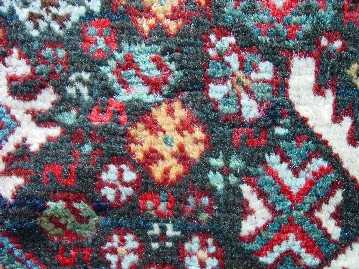
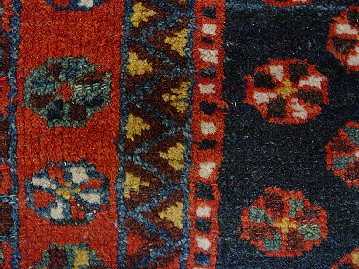
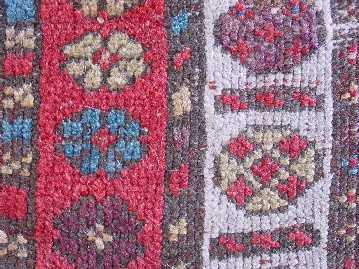
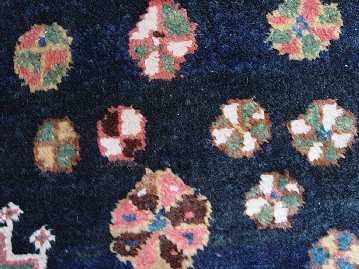
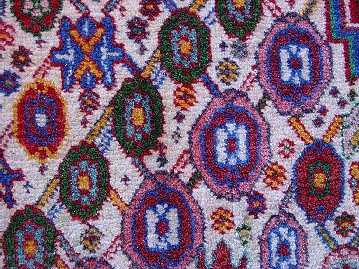
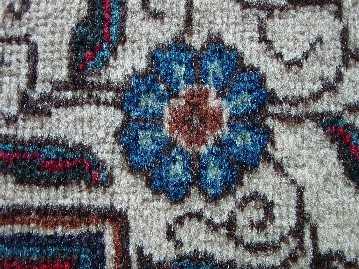
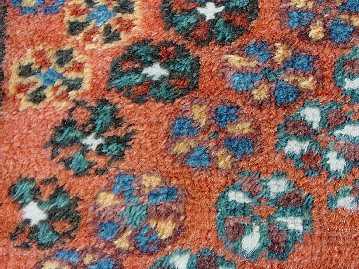
Patrick Weiler
A Rosette is a Rosette is a Rosette?
One of the almost ubiquitous features of Luri weavings is the Rosette. It is
almost possible to identify a Luri rug from the rosette alone.
Here are a few
rosettes. Can you easily tell which are Luri?






Patrick Weiler
Photos #2 and #4, and maybe #7....
Is this Luri?
Patrick, what do you think of this one - Luri, yes or no?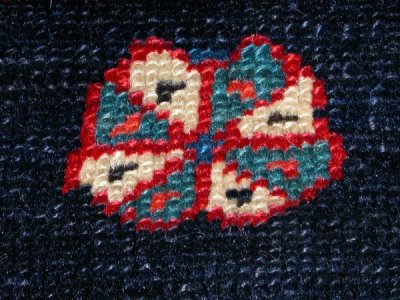
NO
Tracy,
I think it is not Luri, simply because it is not simple enough.
It has those three-knot motifs in the petals. I do not recall having seen them
on a Luri rosette. Khamseh, perhaps? I love the deep blue of the
background.
Numbers 2,4 and 7 are from the rugs in the
salon.
Patrick Weiler
Eyes Wide Open
Tracy,
I must have had my rosette colored glasses on when I replied to
your posting.
Now that I take another look at the examples I posted above, I
see that the fourth photo shows a rosette with markings in the petals of the
rosette, one of which may be three knots in an angle form, similar to yours.
They are not, however, uniform. So, either your rug is a very uniform Lur, or my
rug is a very cheap one! 
And for those few (if any) curious minds, the first photo is a
Khamseh bagface, the third is a Kurdish rug, the fifth is a "modern" (25-30
years old) Qashqai "firuzabad" millefleurs prayer rug and the sixth is a
Tabriz.
Patrick Weiler
My rosette might be considered a "trick question". Here's the piece:
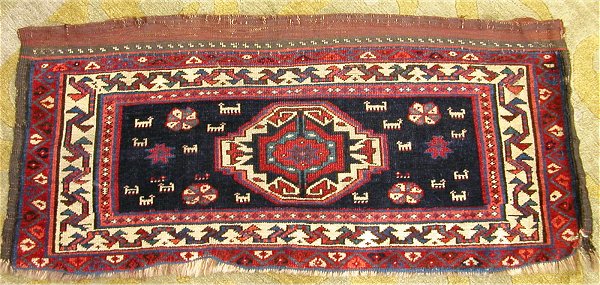
I've
been thinking for some time that we're on much more solid ground attributing by
geographic areas than tribal affiliations. It's been awhile since I read your
initial post-- do you address the weavings of Lurs settled in the Veramin
area?
Introducing - the Veramin Connection
Tracy,
1 I have not addressed the Veramin Luri weavings. Yet.
2
The blue background made me suspicious that your rosette could have been from a
Veramin mafrash panel. We call them mafrash panels, but have you ever seen a
full Veramin mafrash?
The similarity between your rosette and the Luri
rosettes may indicate a family resemblence. You are more than welcome to forge
ahead in this salon with information about the Veramin Lurs.
3 The
geographic area attribution of weavings is probably the most common. We label
things NW Iran, or The Caucasus, or Shiraz, until someone figures out how to
make more specific distinctions. The books Woven Gardens, Opies two books and
others have done a lot for SW Persian weavings. Burns Kurdish book has certainly
given the study of those weavings a jump start. I have heard it said that the
more we know, the more we realize that we really don't know, so we end up
lumping things into the geographic area again.
4 I like your Veramin
piece!
Patrick Weiler
Dear Patrick,
Veramin mafrashes are certainly rare, but I exhibited
one in one of my Masterworks shows. The pile panel which we are all familiar
with is only used on one side. The kilim extends across the bottom and continues
up the other long side, unlike most other mafrash forms which have "finished"
faces on both long sides. The end panels are unusual, as well. They are in a
"salt bag" shape and indeed I have seen a few detached ends surface with that
attribution. Another unusual feature of these ends is that they have alternating
1-2" bands of pile and kilim.
Best Wishes, John Collins
Hello, Rosey
Tracy,
Even if I had slid the old, wooden chest down from among the
cobwebs of the attic, pulled out all of the Shahsavan, Caucasian, Qashqa'i and
Anatolian bags and dug down to the bottom, where I keep my stash of Veramin
mafrash, I would not have necessarily found an analog to your lovely Veramin
Rosette: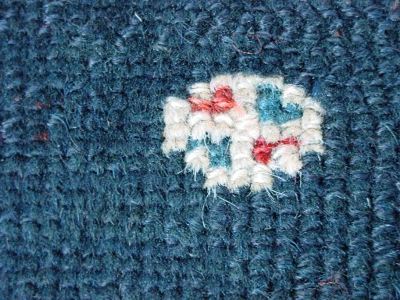
As you can see, my rosette is a smaller, square-ish version,
almost incidental to the overall design: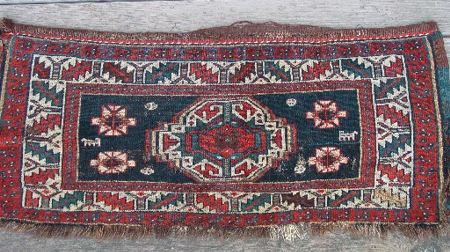
Chuck, you may see another
example of the "blocky meander" border in Tracy's mafrash. Not in mine,
though.
What I like about my mafrash is the row of cheerleaders all
around the major border, some upright with arms stretched out, alternating with
others doing a handstand. Therefore, I assume that this mafrash is evidence for
a powerful Veramin region football league, with cheerleaders on the
sidelines.
And little dogs as mascots.
Deductively
yours,
Patrick Weiler
The Veramin Connection?
Tracy,
Here are a couple more photos of the small rosette from my
Veramin mafrash:
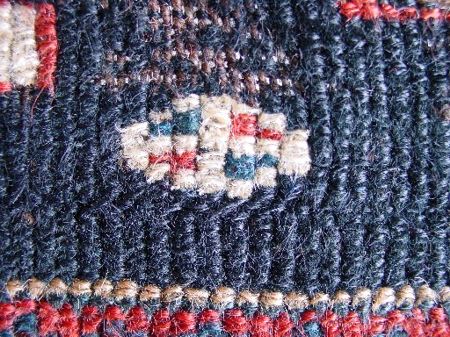
A close look will show that there are offset knots in this
weaving!
Marla Mallett may be interested in using this example in her Offset
Knots project.
You can easily see the offset knots by looking at the white
border stripe. The blue field knots are "between" the white knots. You can see
on the upper photo that the blue knots "waver" above and to the right of the
rosette. On the lower photo, it looks like a river of blue knots swings out to
go around the rosette "rock" in the river.
So, Tracy, does your mafrash
have any offset knots?
We know that many tribes mingle in the Veramin area.
Perhaps this mafrash was woven by a Kurdish woman and yours, if it has no offset
knots, may have been woven by a Luri woman who used her tribal rosette,
too!
Wavering,
Patrick Weiler
Patrick, I never even considered looking for offset knots... I'll have to check and will post results here.
Patrick, I checked.... no offset knots in the Veramin piece I pictured earlier. I have another one I can check, if I remember to dig it out. Now you've got me wondering what conclusions we might draw from offset-knot-Veramin-rosettes versus non-offset-knot Veramin rosettes...
confusing conclusion
Tracy,
The offset knotting in this mafrash is not used to articulate
the design features, it is used only in various areas of the field and along
part of the single-line border stripes surrounding the field. Kurdish weavers
use offset knots to sharpen diagonals or change the angle of a circle in their
design motifs. I have no idea why this weaver would use offset knots to no
apparent purpose.
It does make some of the horizontal border lines thinner,
since the rows of knots above and below can be closer to the row in between.
Perhaps the weaving was "misbehaving"  The weaver may have offset the knots to compensate for an unknown
shortcoming in the weaving process. But I am unaware of this technique being
used for that purpose in any other weavings.
The weaver may have offset the knots to compensate for an unknown
shortcoming in the weaving process. But I am unaware of this technique being
used for that purpose in any other weavings.
I have a Varamin bagface with a
similar border, but no offset knots. This mafrash, though, looks quite a bit
older.
Daniel Deschuyteneer shows a Luri rug with offset knotting on Marla
Mallett's web site page on offset knotting:
http://www.marlamallett.com/offset_knotting.htm
Perhaps
there is some connection between Luri offset knotting and Varamin offset
knotting.
Patrick Weiler